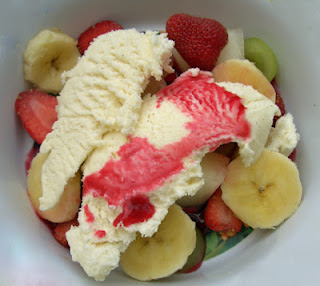It is June. It is strawberry season. It is time to make strawberry jam.
It is funny how popular strawberry jam is. It seems that we were all brought up eating strawberry jam and it is the one that is most likely to be in our cupboards and the one offered with a scone for cream tea. It is of no surprise to me that by the time strawberries are ready again in June I have back ordered for strawberry jam and I know however many strawberries I harvest I will sell out before next June.
For many people strawberry jam is the first jam that they have a go at making - maybe at the request of their family or after an over-enthusiastic trip to a pick-your-own farm. However, this is perhaps a little unfortunate as it is probably the trickiest jam to make. It all comes down to strawberries being a low pectin fruit. Pectin is the "magic ingredient" in fruit that causes a jam to reach a setting point. Some fruit, such as strawberries, some cherry varieties and pears are low in pectin, whilst other, such as blackcurrants, gooseberries and apples are high in pectin. The higher the pectin the easier it is to get a successful set. My advice, if you fancy having a go at making jam wait until July and try blackcurrant jam.
Should you decide to make strawberry jam then here are my tips for attaining a successful set.
1) Use some unripe fruit: The riper fruit gets, the lower the pectin levels in it. At the same time, the riper the fruit gets, the better the flavour becomes. When making a jam try to use a mixture of nice ripe fruit and some slightly underripe fruit for both flavour and set.
2) Add a lemon: Most strawberry jam recipes recommend the use of lemon juice, added at the same time as the sugar. The idea behind this is that the acidity in the lemon helps to extract the pectin in the fruit. My experience has shown that if the lemon juice is added right at the beginning of the whole process it is easier to reach a good set. Make sure it is freshly squeezed lemon juice.
3) Add pectin: All commerically produced jam and a lot of homemade jam use added pectin to help to reach a good set. Even River Cottage's Pam the Jam does this. One argument for doing this is that it is likely to reach the setting point sooner than it would without the added pectin and if a jam is boiled for too long it darkens and losing some of the fruitiness in the flavour. Pectin can be added in a variety of ways. Jam sugar has pectin added to it and is used as a direct replacement for granulated sugar. Liquid pectin can be bought in bottles and added as instructed. It is also possible to make your own pectin stock by boiling up apple cores, pips and peel. I do this when I'm making a batch of something with apples such as jam, chutney or crumble. Once it has been boiling for an hour or so, strain the liquid out and test a small sample of it with a few drops of methylated spirits. If you have a good pectin stock a small springy ball should form in the liquid. Note methylated spirits is poisonous so dispose of this test sample carefully. The stock can then be frozen in ice cube trays and the ice cubes of pectin can be dropped into your jam as needed when the sugar is added. I use apple pectin stock for getting pear jam to set but have never actually found it necessary to add pectin to strawberry jam.
4) Combine the strawberries with a high pectin fruit: Life is a lot easier if rather than trying to make pure strawberry jam, the strawberries are combined with a high pectin fruit such as gooseberries. Strawberry and gooseberry jam is very easy to set yet the dominant flavour is strawberry.
5) Be patient and check for set thoroughly: Strawberry jam will set eventually if boiled for long enough so be patient. I would also recommend stirring it occasionally to check that it isn't overcooking at the bottom and beginning to burn because that will ruin the whole batch and you will cry! Although jam is supposed to set at 104°C, don't totally rely on a thermometer to be sure it has set - instead put a little on a cold saucer and push it with your finger. If it wrinkling the jam is set. If it doesn't then boil it for longer.
If you get to the stage where you have bottled your jam and it is still runny, do not despair, the whole lot can be emptied back into your preserving pan and boiled up again until the setting boil is reached. This is not ideal as it is more time consuming and you have to wash the jars up before they can be refilled but it will not damage the jam so is useful to know. Failing that, just use your jam differently. Rather than trying to balance it on your toast, use it as a flavouring in yoghurt or ice-cream, use it has a sauce with cheesecake or mix it with milk and call it milkshake!





No comments:
Post a Comment